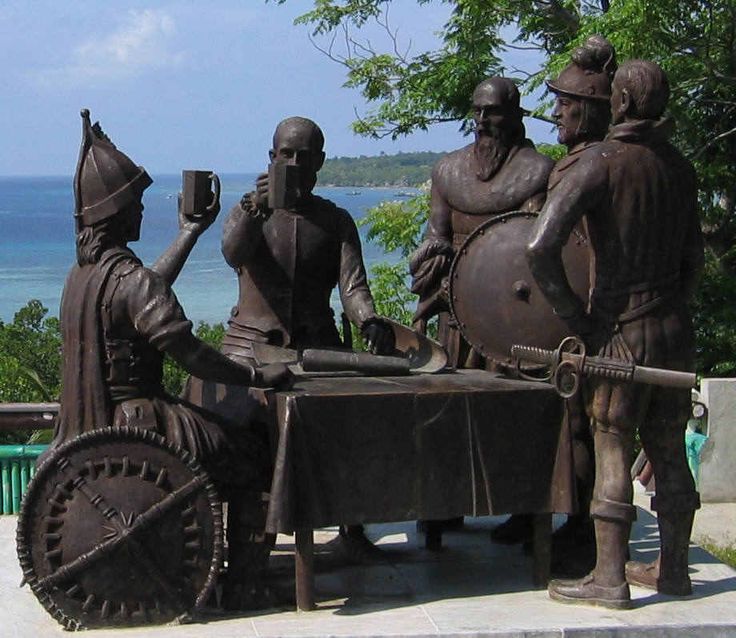History of Christianity in the Philippines through the ‘Magellan’ song of Boholano Yoyoy Villame

Photo of Sandugo sculpture by Boholano National Artist Napoleon Abueva
March 16 is a significant date in history of Christianity in the Philippines — it was in 1521 when Ferdinand Magellan arrived in the Philippines while it was in 1565, or 44 years later, when the Legazpi-Sikatuna blood compact occurred in Bohol.
“On March 16, 1521, when Philippines was discovered by Magellan. They were sailing day and night across the big ocean. Until they saw a small Limasawa island.”
My early grasp of the history of Christianity in the Philippines at a young age can perhaps be traced to the popular “Magellan” song of fellow Boholano Yoyoy Villame.
“Magellan” was Villame’s first recording in 1972 that became the top-selling record in the Visayas-Mindanao region which narrated the arrival of Portuguese explorer Ferdinand Magellan in the country in 1521.
Villame was a native of Calape, Bohol, and was the youngest of 10 children of a fisherman father and fish seller mother. Calape is adjacent to Tubigon which is the hometown of the Gorechos.
He blended Filipino folk melodies, popular tunes and nursery rhymes for his music and then added witty, comedic lyrics with a grammar of mixed Tagalog, Cebuano and English.
“When Magellan landed in Cebu City. Rajah Humabon met him, they were very happy. All people were baptized and built the church of Christ. And that’s the beginning of our Catholic life.”
Christianity was brought to the Philippines in 1521 when Magellan landed in on the small island of Limasawa in Cebu. Magellan was heading a Spanish expedition in an effort to find a western sea route to the rich Spice Islands of Indonesia.
On March 31, 1521, the first Mass was celebrated where some 800 were baptized to form the first Catholic community, including Rajah Humabon.
The Sto. Nino de Cebu became the oldest Christian artifact in the Philippines as a gift from Magellan to Rajah Humabon,on account of their baptism. Unfortunately, he was killed a month later during the Mactan battle led by Lapu-Lapu.
The Philippine archipelago, which was named after King Philip II, became a colony of Spain until 1898.
Coincidentally, it was on March 16, 1565 when the Legazpi-Sikatuna Blood Compact, Pacto de Sangre, or Sandugo occurred, or 44 years after the arrival of Magellan in 1521.
It was a blood compact, performed in Hinawanan Bay, barangay Hinawanan, Loay, Bohol between the Spanish explorer Miguel López de Legazpi and Datu Sikatuna, chieftain of Bohol to seal their friendship following tribal tradition.
Legazpi led the fifth, the last, and the most successful of all Spanish expeditions after Magellan in 1521, García Jofre de Loaísa in 1525, Sebastian Cabot in 1526, Álvaro de Saavedra Cerón in 1527, and Ruy López de Villalobos in 1542.
The Legazpi expedition resulted in the discovery of the tornaviaje or return trip to Mexico across the Pacific that started the Manila galleon trade which lasted two and a half centuries.
This is considered the first treaty of friendship between the Spaniards and Filipinos. “Sandugo” is a Visayan word which means “one blood” to make a friendly alliance with them, stressing that they are not barbaric Portuguese but rather peaceful Spaniards. The island was previously ransacked by the Portuguese two years earlier during the fall of Bool Kingdom.
Another blood compact was performed later between Legaspi and Datu Sigala, the chieftain of Loboc on March 28, 1565.
After Brazil and Mexico, the Philippines is the third largest Catholic population in the world with about 84 per cent of the total country population are Catholics per 2020 census.
A telltale sign of Catholicism is the proliferation of fiestas to honor patron saints or other religious occasions.
Pre-Hispanic Filipinos had their own set of cultures and traditions, including worshipping many gods or anitos. They made regular ritual offerings to placate the gods.
When Spanish missionaries came to the Philippine, they discovered that the fiesta was a helpful tool to help teach Filipinos the Roman Catholic faith and its saints, as indigenous Filipinos already had a sense of patronage of a deity for their mostly pagan practices and rituals.
It is jokingly said Bohol is “sinking” in May because the population of the island during this month is multiplied twice, thrice, or even four times due to the fiestas.
Known as a reverse exodus or “balikbarrios,” once the first of May strikes, people from abroad, from Manila, and even nearby provinces begin flocking back to their small barrios of Bohol.
Date of fiestas in Bohol vary from town to town, yet most of the feast days fall on the month of May, earning it the name the “Fiesta Month.”
Characterized by an abundance of food and merriment, not a single day will pass without a fiesta somewhere on the island.
The fiesta is celebrated as a thanksgiving for blessings bestowed upon the people, the livelihood and life of the town.
(Peyups is the moniker of the University of the Philippines. Atty. Dennis R. Gorecho heads the Seafarers’ Division of the Sapalo Velez Bundang Bulilan Law Offices. For comments, e-mail info@sapalovelez.com, or call 09175025808 or 09088665786.)
RELATED STORIES
Philippine history from primary sources
Boat as a metaphor for our maritime culture
Flowers for Lolas: Remembering the 1945 Rape of Manila
Fishers as victims of human trafficking
Disclaimer: The comments uploaded on this site do not necessarily represent or reflect the views of management and owner of Cebudailynews. We reserve the right to exclude comments that we deem to be inconsistent with our editorial standards.
